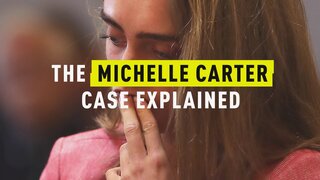Create a free profile to get unlimited access to exclusive videos, breaking news, sweepstakes, and more!
What Was Michelle Carter's Life Like Before Conrad Roy Committed Suicide? Lonely
Michelle Carter appeared to be popular, pleasant, maybe even average. But inside, as the HBO documentary "I Love You, Now Die" shows, she was lonely and disturbed.

Looks can be deceiving.
Michelle Carter may have seemed like a normal teen before her boyfriend, Conrad Roy III, died by suicide after filling up his truck with carbon monoxide. But that was before text messages between the couple revealed she was disturbed, arguably delusional, and possibly even psychotic, according to a doctor who testified for her defense team after she was put on trial for Roy's death.
Carter and Roy had exchanged thousands of text messages, where Roy often confided in her about his suicidal thoughts. And in the weeks before his death, Carter started zealously encouraging the idea, urging him to finally commit the deed. It was these text messages — and a text to a friend where she claimed Roy had second thoughts and tried to leave the truck but she told him to get back in — that had her found guilty of involuntary manslaughter in 2017.
Photos before Roy's 2014 death show Carter as a smiling, blonde, blue-eyed white American teen posing alongside a group of female peers at social outings. One may have presumed she was popular, pleasant and well-liked based off her appearance. She’s pictured alongside other girls in matching outfits, looking as though the group was destined to be sorority sisters. She played softball and was voted as “most likely to brighten your day” by her high school classmates, according to the new HBO documentary "I Love You, Now Die."
Jesse Barron, who wrote a piece on the case for Esquire, described her as a suburban girl from Plainville, Masschusettes. In that town of 8,000 she did not appear to be spectacularly remarkable but she did appear to be doing well.
“She was a good student, she was a polite, appealing teenager who adults felt respected by so outwardly this was like as straight white American teenage life as you can get," Barron said in the doc.
Dr. Peter Breggin, a psychiatrist who testified in Carter’s trial for the defense, said she was known in the community as a “sweet and caring young woman.”
However, as the documentary shows, her interior thoughts didn’t necessarily match with how others perceived her. As for the photos that made it look as though she was a girl with lots of friends, it wasn't the reality. Most of the friendships that Carter had weren’t as deep as she’d like them to be. In fact, the prosecution in Carter’s trial argued that getting attention from girls who appeared to ignore her may have been a motive for her to get Roy to die.
The prosecution described her as “needy” and as someone who didn’t have any close friends. Even Breggin called her "desperate," describing her as having a "hole no one can fill."
"Yeah I have school friends that all say they love me but that doesn't mean s--t when no one ever asks to hang out with me," Carter wrote in one text, according to the documentary. In another, she complained that she felt like even her own family doesn't like her half the time.
Carter texted the friends she did have “incessantly," according to prosecutors.
“If Michelle had a defining characteristic, it was a cheery relentlessness,” Barron wrote in his Esquire piece. “If you were kind to her, she would thank you so much it was confusing. If she upset you, she would apologize fifty times, then apologize for apologizing. Not quite part of any group, she sometimes overcompensated, lavishing attention in sudden intense waves.”
The prosecution claimed Carter wanted to get the attention of her classmates and that Roy’s suicide was just the ticket for that attention.
Olivia Mosolgo, one girl who Carter thought was a friend, said in court she thought of Carter as more of a teammate than a friend. She also testified that Carter expressed to her that she felt like she had no friends. Lexie Eblan, a girl who Carter is photographed hugging, nearly squeezing, from behind, testified that their friendship was mostly an “in-school friendship.”
She said Carter asked her to hang out outside of school but Ebian always rejected her.
Then, there was a girl known only as Alice, a girl she played softball with and whom she thought she got very close with.
"She just made me feel things no one else made me feel like she was my best friend,” she described the friendship in a text. She went on to say, "I thought it was a phase at first like i thought we were just really good friends. but we started talking like a relationship would, flirting and stuff.”
Alice apparently didn’t feel the same way. She and her mom told Barron the relationship wasn’t reciprocal and that Carter was a sociopath, according to Barron. Carter’s so-called friends didn’t appear able or interested to have her around for long periods of time. Perhaps it all stemmed from Carter's mental health issues. Breggin testified during Carter’s trial that she was on medication that clouded her judgment and that she, too, was struggling with suicidal thoughts. He said Carter was taking Prozac for years before switching to Celexa three months before Roy died. He believes the medication had an adverse affect on her, and that it led to her becoming “psychotic,” “deluded” and “disturbed.”
Carter also had a severe eating disorder and would self-mutilate, according to the documentary.
“Michelle wanted the confidence she saw others having,” her peer Evan Andrews told Barron for his Esquire article.
Barron went into detail in the HBO doc about Carter’s inability to truly know herself, a determination he makes, in part, because of her unhealthy obsession with fictional stories like “Glee.” In fact, Carter would often incorporate verbatim quotes from the show in messages to and about Roy, indicating that she romanticized their relationship, according to Barron.
Barron said Carter "had this desire for things to be more intense, more like stories than they really were.”
Romanticized or not, the only legitimate friendship Carter had appeared to be with Roy and she encouraged him to end his life. Barron noted in the doc that even he was sometimes mean to her. Still, the two exchanged thousands of texts and Roy felt comfortable enough with Carter to reveal his deepest and most disturbing thoughts.
Carter appeared to get some of the attention she was craving from classmates when she lied about Roy going missing days before he actually did. The prosecution claimed this was Carter doing a test run days before Roy ended his life by texting the group of girls she wanted to be close with.
“They are paying attention to her now,” prosecutor Maryclare Flynn testified, as shown in the HBO doc. “So she has to make it happen. She has to make him kill himself so that she can continue to get that attention and not be known as a liar.”
Then, when Roy actually died, Flynn said Carter “suddenly became important.”
Mosolgo testified she went over to comfort her and that a lot of people were giving her attention, the attention that the prosecution claimed Carter felt she deserved.
Carter is currently serving out her prison sentence. She was sentenced in 2017 to two and a half years in prison, although her sentence was suspended until 2019 while her legal team filed an appeal.



















